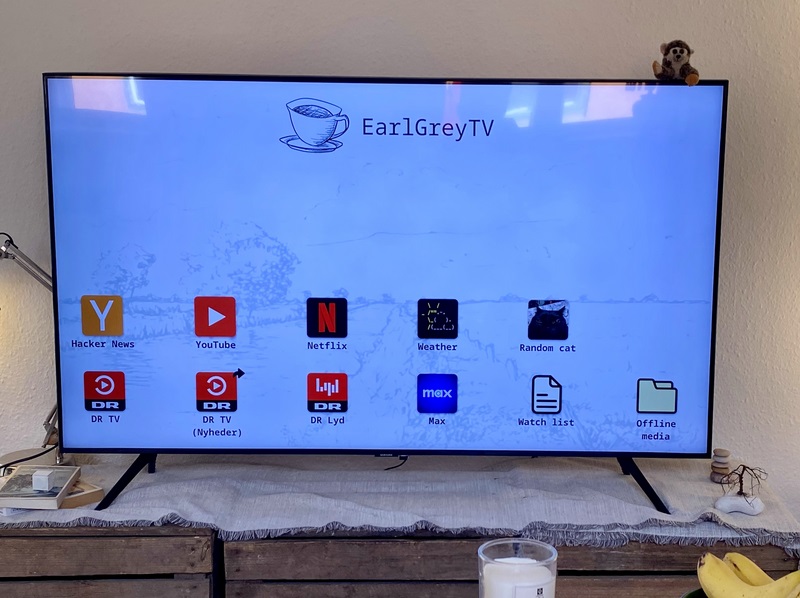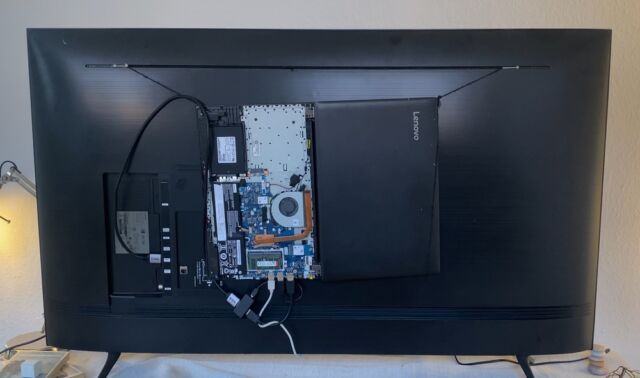
Smart TV owners have been subjected to a growing amount of ads and tracking. Ad fatigue, only worsened by a trend that sees streaming providers trying to force customers into subscriptions with commercials, is understandable. We’re at the point where someone would rather use a broken laptop dangling off a TV than be subjected to the watchful eye of the TV’s native operating system.
Earlier this month, as spotted by Tom’s Hardware, a blogger named Carl Riis, who says he’s a software engineer, shared his DIY project, a Linux-based “smart TV.” Riis’ project doesn’t stand out because it’s the most unique, clever, or clean. In fact, if you’re the type of person willing to pay a lot for TVs with strong aesthetic appeal, like TVs that can look like artwork or appear transparent, you’ll be put off by the EarlGreyTV. The system uses an old Lenovo laptop that has a broken keyboard and is attached to a TV by a string. As Riis wrote: “This may look a little insane, but it has been a great way to keep things neat while retaining access to the laptop.”

The laptop is broken because Riis spilled tea onto the keyboard years ago. The keyboard stopped working, making it hard to turn the laptop on and off. “I have to short two specific pins where the keyboard connects to the motherboard. For this reason, I have the back removed, which probably also helps it run less hot,” Riis wrote.
Riis put some extra work in so that this project is more than just simply using a laptop of a smart TV to stream and using a TV as a monitor. His computer views its HDMI connection as an app and uses Debian Linux and, due to its simplicity, Sway as a desktop environment. Riis set Sway to open the Firefox browser full-screen upon login. He made Firefox’s homepage, which has shortcuts to streaming services and whatever else Riis wants with a custom HTML file. He also customized Firefox using a userChrome.css file to give the browser a more traditional TV appearance, including no visible address bar and an on-screen pop-up that appears when the volume is adjusted.
Riis knows that his TV setup isn’t the simplest and has flaws but says it “works for my needs.” The EarlGreyTV is far from the prettiest answer to the drawbacks of smart TVs but still has appeal as an alternative to the ads and tracking that have become prominent in smart TV software.
Beyond a faulty laptop, Riis says his project uses a 55-inch Samsung smart TV bought at a discount during Black Friday. Per Riis’ blog, even the display isn’t perfect for the project:
Ideally, I would have wanted a dumber TV screen—simply showing display output. But this one was on sale, and I bought it. I’ve seen people do really cool stuff, like triggering the TV’s hidden service menu to dumb it down completely. I might do that at some point, but for now, the regular settings could get the Tizen OS out of the way enough for me.
Riis also got a USB-powered CEC adapter so that the air mouse could turn the TV and laptop on and off simultaneously, and since his 5-year-old computer’s HDMI port didn’t support the optional feature on its own. Riis even shared ways to perform iPhone casting with his design.
The package also includes an air mouse serving as a remote control that Riis says has a learning curve and feels a little “flimsy.”
Smart TV alternative
Riis would rather use a tea-dipped laptop dependent on a string and adaptor for entertainment than the smart TV OSes already packaged in brand-name TVs. “I’m not here to bash other smart TV interfaces, but the short version of why I don’t like them is: tracking, ads, and lack of control,” Riis wrote.
TV OS operators, which include Roku, Vizio, Amazon, and LG, have a strong interest in building their ad businesses and abilities for ad tracking. Combined with the incessant push from streaming providers to get viewers to watch ads, it can be nearly impossible to get from your TV’s home screen to the show or movie you came to watch without enduring an advertisement first. Roku, for example, recently started showing video ads on the Roku OS home screen, while Amazon has also been creating more types of Fire TV ads, including ads tied to the upcoming generative AI version of Alexa.
Someone like Riis deciding to spend hours crafting this imperfect alternative is the embodiment of how much ad fatigue smart TV users are facing. Of course, Riis isn’t the only one sharing ways to watch TV online without using a smart TV OS or who’s looking for smart TV alternatives due to privacy concerns.
Beyond ad fatigue, Riis is pleased with his ability to tweak his web-based TV and movie-watching experience with browser extensions “like ad/sponsor blockers or set site-blocking schedules.”
Riis’ project is on GitHub, and he also shared a video about his work on YouTube, which is below:
Showing my custom smart TV – EarlGreyTV




















+ There are no comments
Add yours